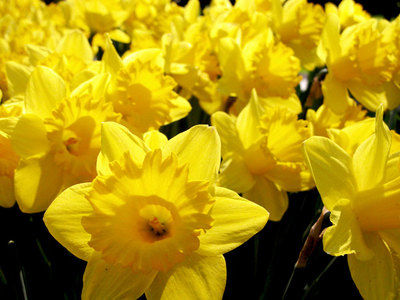
Many of us garden in the shade year-round. Others have sun in the summer, but shade from fall through spring, as the sun’s arc becomes lower in the southern sky. Here are some encouraging tips if this describes your garden.
Raising tomatoes
If you’re new to growing vegetables, you might be discouraged that your tomatoes are still green. Fear not. Tomatoes don’t need direct sunshine to ripen — they only need warmth. That’s why green tomatoes will ripen on a kitchen windowsill.
Don’t be tempted to prune leaves out of the way so that whatever sunshine you do get can hit your tomatoes. This can sunburn the fruit if there’s a hot day, and the result will be a white spot that eventually turns black, hard and inedible.
Growing bulbs
What about bulbs in the shade? If you’ve dreamed about drifts of colorful flowers under your trees in the spring but didn’t think they would bloom in the shade, think again. Some bulbs manage to grow just fine beneath trees — even evergreen trees.
Many from the daffodil clan, including jonquils and narcissus, will grow, bloom and naturalize year after year under tree canopies or other lightly shaded areas. Common types to try are Golden Harvest; the classic, large yellow King Alfred daffodil; and Dutch Master, with pure gold flowers. Barrett Browning has a soft, butter-yellow corolla and a frilly, pumpkin-orange tube.
To make sure your bulbs stand out in the landscape, figure at least 20 to 40 bulbs per drift. Be sure to pick up a sturdy, foot-operated bulb planter to better dig through surface roots and hard ground.
In a time when money is short, naturalizing daffodils is an affordable way to grow more flowers, and they’ll come back every year, without losses from deer and gophers.
Squirrels, mice and moles, however, are observant and crafty. Once they discover newly planted bulbs, they’ll assume they are food. Just disturbing the earth tips them off.
Daffodils and narcissus bulbs are unappetizing, but if they are dug up and left exposed with just a nibble taken out of them, so much for any spring flower display.
Protect your bulbs with wire baskets or spray them with foul-tasting repellent, letting the spray dry before planting. You can also bury the bulbs with ground-up shells.
Planting bulbs alongside a path also makes for a beautiful look come spring.
Choosing groundcover
If you installed a flagstone or stepping stone path or sitting area this fall, now is the best time to plant groundcover in between. Low, sturdy types that can withstand some foot traffic include blue star creeper for regularly irrigated areas, and creeping, woolly or elfin thyme for drier spaces.
Make sure you have enough planting mix between the pavers for the plugs to grow. Fill the largest spaces first and allow them to spread into the little cracks.
Mixing groundcover types looks great, as long as they have the same water requirements. Low-growing pennyroyal and Corsican mint smell wonderful when you walk on them, as does chamomile, although you will need to mow the latter occasionally to keep it neat and tidy.
Whatever you choose for your project this fall, you will love the look come spring.
•Jan Nelson, a California certified nursery professional at Plant Works in Ben Lomond, will answer questions about gardening in the Santa Cruz Mountains. E-mail her at ja******@*ol.com.












